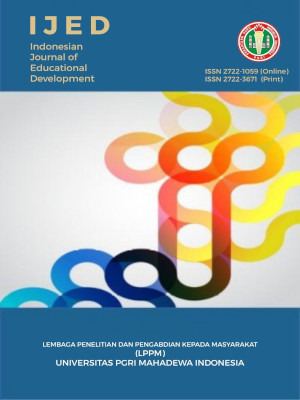Developing a case-based e-book for office communication: Enhancing critical thinking and practical skills
DOI:
https://doi.org/10.59672/ijed.v6i2.4724Keywords:
Case method, Development, Education, E-book, Office communicationAbstract
This research aims to produce a product in the form of a case method-based office communication e-book that meets the requirements of validity and usability. Novelty in research emphasizes a unique, contemporary, and specific approach to training students to communicate effectively in the office, utilizing books integrated with technology and a case-based learning approach. This research is a development study utilizing a 4-D model. The instruments used to measure the feasibility and practicality of this textbook include validation sheets and student response questionnaires. The results of data analysis show that, according to the expert's assessment, both in terms of material, language, and graphics, it is highly feasible, with an average feasibility of 92.10% and an average score of 90.2% among student responses. Based on these results, this case method-based office communication e-book is feasible and can be used in classroom learning. Therefore, the implications of developing e-books in office communication emphasize the possibility for lecturers and students to learn more quickly, flexibly, and contextually, so that students can apply concepts from office communication to face the demands of a very dynamic work environment.
Downloads
References
A. Buzzetto-More, N., Guy, R., & Elobaid, M. (2007). Reading in a digital age: E-books are students ready for this learning object? Interdisciplinary Journal of E-Skills and Lifelong Learning, 3, 239–250. https://doi.org/10.28945/397
Adebayo, B. R. (2018). Curriculum And Textbook Program Development Provision Comparison In China, Mexico, The Caribbean And Nigeria: The Way Forward. Library Philosophy and Practice (e-Journal).
Alhammad, R., & Ku, H.-Y. (2019). Graduate students’ perspectives on using e-books for academic learning. Educational Media International, 56(1), 75–91. https://doi.org/10.1080/09523987.2019.1583460
Andrews-Todd, J., & Forsyth, C. M. (2020). Exploring social and cognitive dimensions of collaborative problem solving in an open online simulation-based task. Computers in Human Behavior, 104, 105759. https://doi.org/10.1016/j.chb.2018.10.025
Asep, A. (2023). The urgency of case method in geography learning. JPG (Jurnal Pendidikan Geografi), 10(2). https://doi.org/10.20527/jpg.v10i2.16881
Asrowi, A., Hadaya, A., & Hanif, M. (2019). The impact of using the interactive e-book on students’ learning outcomes. International Journal of Instruction, 12(2), 709–722. https://doi.org/10.29333/iji.2019.12245a
Aswirna, P., & Ritonga, A. (2020). The development of discovery learning - based e-book teaching e-book based on kvisoft flipbook maker on science literation. Hunafa: Jurnal Studia Islamika, 17(2), 47–79. https://doi.org/10.24239/jsi.v17i2.590.47-79
Bergström, A., & Höglund, L. (2020). E-books: In the shadow of print. Convergence: The International Journal of Research into New Media Technologies, 26(4), 895–911. https://doi.org/10.1177/1354856518808936
Changwong, K., Sukkamart, A., & Sisan, B. (2018). Critical thinking skill development: Analysis of a new learning management model for Thai high schools. Journal of International Studies, 11(2), 37–48. https://doi.org/10.14254/2071-8330.2018/11-2/3
Cole, F. (2024). Project-based learning in further and higher education. In An Educator’s Guide to Project-Based Learning (pp. 80–86). David Fulton Publishers. https://doi.org/10.4324/9781003424345-12
Erviyenni, Aldresti, F., & Haryati, S. (2023). Web-based 21st-century skills-oriented e-module for chemistry teacher candidates. Jurnal Edutech Undiksha, 11(1).
Evi Yupani & Widana, I. W. (2023). The impacts of the stem-based inquiry learning models on critical thinking and concept mastery. Indonesian Research Journal in Education, 7(1), 171-184. https://doi.org/10.22437/irje.v7i1.24227
Fauzi, A., Ermiana, I., Nur Kholifatur Rosyidah, A., & Sobri, M. (2023). The effectiveness of case method learning in view of students’ critical thinking ability. Pedagogia : Jurnal Pendidikan, 12(1), 15–33. https://doi.org/10.21070/pedagogia.v11i1.1544
Gorbi Irawan, A., nyoman Padmadewi, N., & Putu Artini, L. (2018). Instructional materials development through 4D model. SHS Web of Conferences, 42, 00086. https://doi.org/10.1051/shsconf/20184200086
Gu, X., Wu, B., & Xu, X. (2015). Design, development, and learning in e-textbooks: What we learned and where we are going. Journal of Computers in Education, 2(1), 25–41. https://doi.org/10.1007/s40692-014-0023-9
Günther, S. L., Fleige, J., zu Belzen, A. U., & Krüger, D. (2019). Using the case method to foster preservice biology teachers’ content knowledge and pedagogical content knowledge related to models and modeling. Journal of Science Teacher Education, 30(4), 321–343. https://doi.org/10.1080/1046560X.2018.1560208
Hamiyati, H., Pada, A. U. T., Safrida, S., Khairil, K., & Artika, W. (2022). Application of case method model based on character values in reproductive system materials to improve critical thinking and conation skills. Jurnal Penelitian Pendidikan IPA, 8(5), 2387–2391. https://doi.org/10.29303/jppipa.v8i5.2045
Hutsalo, L., Skliar, I., Abrosimov, A., Kharchenko, N., & Ordanovska, O. (2024). Strategies for developing critical thinking and problem-based learning in the modern educational environment. Multidisciplinary Science Journal, 6, 2024ss0209. https://doi.org/10.31893/multiscience.2024ss0209
Jaya, S., Hamzah, S. ., & Yunita, W. . (2025). Needs analysis for critical reading e-book based on problem-based learning: Perspectives from EFL students, lecturers, and stakeholders. Indonesian Journal of Educational Development (IJED), 6(1), 55-67. https://doi.org/10.59672/ijed.v6i1.4682
Kirby, K., & Anwar, M. N. (2020). An application of activity theory to the “problem of e-books.” Heliyon, 6(9), e04982. https://doi.org/10.1016/j.heliyon.2020.e04982
Klebba, J. M., & Hamilton, J. G. (2007). Structured case analysis: Developing critical thinking skills in a marketing case course. Journal of Marketing Education, 29(2), 132–139. https://doi.org/10.1177/0273475307302015
Larson, L. C., & Miller, T. N. (2011). 21st century skills: Prepare students for the future. Kappa Delta Pi Record, 47(3), 121–123. https://doi.org/10.1080/00228958.2011.10516575
Makwanya, C., & Oni, O. (2019). E-books preference compared to print books based on student perceptions: a case of university of fort hare students. International Journal of Interactive Mobile Technologies (IJIM), 13(12), 236. https://doi.org/10.3991/ijim.v13i12.10840
Muir, L., & Hawes, G. (2013). The case for e-book literacy: undergraduate students’ experience with e-books for course work. The Journal of Academic Librarianship, 39(3), 260–274. https://doi.org/10.1016/j.acalib.2013.01.002
Ningsih, W., Arwita, W., Hardinata, A., & Purwanto, E. (2022). Creating interactive e-book based on project with tutorial video. Proceedings of the 4th International Conference on Innovation in Education, Science and Culture, ICIESC 2022, 11 October 2022, Medan, Indonesia. https://doi.org/10.4108/eai.11-10-2022.2325377
Nuryana, I., Thomas, P., Kardiyem, K., Suranto, S., & Disman, D. (2022). The effectiveness of the case method learning model to improve critical thinking skill. Proceedings of the 4th International Conference on Economics, Business and Economic Education Science, ICE-BEES 2021, 27-28 July 2021, Semarang, Indonesia. https://doi.org/10.4108/eai.27-7-2021.2316882
Nyumba, tobias O., Wilson, K., Derrick, C. J., & Mukherjee, N. (2018). The use of focus group discussion methodology: Insights from two decades of application in conservation. Methods in Ecology and Evolution, 9(1), 20–32. https://doi.org/10.1111/2041-210X.12860
Pan, G., Seow, P.-S., Shankararaman, V., & Koh, K. (2021). An exploration into key roles in making project-based learning happen. Journal of International Education in Business, 14(1), 109–129. https://doi.org/10.1108/JIEB-02-2020-0018
Peel, K. L. (2020). A beginner’s guide to applied educational research using thematic analysis. Practical Assessment Research and Evaluation, 25(1).
Permendiknas. (2008). Peraturan Menteri Pendidikan Nasional Republik Indonesia No. 2 Tahun 2008 Tentang Buku.
Purnadewi, G. A. A., & Widana, I. W. (2023). Improving students’ science numeration capability through the implementation of the PBL model based on local wisdom. Indonesian Journal of Educational Development (IJED), 4(3), 307-317. https://doi.org/10.59672/ijed.v4i3.3252
Rezaei, A. R. (2023). Comparing strategies for active participation of students in group discussions. Active Learning in Higher Education, 24(3), 337–351. https://doi.org/10.1177/14697874221075719
Ririen, D., & Irawati, I. (2023). Implementasi pembelajaran berbasis case method dalam meningkatkan kemampuan berkomunikasi dan critical thinking mahasiswa. Jurnal Dedikasi Pendidikan, 7(1), 27–38. https://doi.org/10.30601/dedikasi.v7i1.3443
Rokusek, S., & Cooke, R. (2019). Will library e-books help solve the textbook affordability issue? using textbook adoption lists to target collection development. The Reference Librarian, 60(3), 169–181. https://doi.org/10.1080/02763877.2019.1584597
S. Thiagarajan, D. S. Semmel, & M. I. Semmel. (1974). Instructional development for training teachers of exceptional children: A sourcebook. . Council for Exceptional Children.
Sadiman, A. S., R. Rahardjo, Agung Haryono, & Harjito. (2018). Media Pendidikan: Pengertian, Pengembangan dan Pemanfaatannya (Cetakan ke-18). Rajagrafindo Persada.
Saputra, M. D., Joyoatmojo, S., Wardani, D. K., & Sangka, K. B. (2019). Developing Critical-thinking skills through the collaboration of jigsaw model with problem-based learning model. International Journal of Instruction, 12(1), 1077–1094. https://doi.org/10.29333/iji.2019.12169a
Sari, A. P., & Munir, M. (2024). Pemanfaatan teknologi digital dalam inovasi pembelajaran untuk meningkatkan efektivitas kegiatan di kelas. Digital Transformation Technology, 4(2), 977–983. https://doi.org/10.47709/digitech.v4i2.5127
Schröter, E., & Röber, M. (2022). Understanding the case method: Teaching public administration case by case. Teaching Public Administration, 40(2), 258–275. https://doi.org/10.1177/01447394211051883
Sukendra, I. K., Widana, I. W., Juwana, D. P. (2023). Senior high school mathematics e-module based on STEM. Jurnal Pendidikan Indonesia, 12(4), 647-657. https://doi.org/10.23887/jpiundiksha.v12i4.61042
Sulistiyono, R., Andayani, A., & Anindyarini, A. (2023). Digital textbooks indonesian learning planning based on project learning, contextual approaches, and case methods. Proceedings of the 2nd International Conference of Humanities and Social Science, ICHSS 2022, 17 December 2022, Surakarta, Central Java, Indonesia. https://doi.org/10.4108/eai.17-12-2022.2333465
Sumandya, I. W. & Widana, I W. (2022). Reconstruction of vocational-based mathematics teaching materials using a smartphone. Journal of Education Technology, 6(1), 133-139. https://dx.doi.org/10.23887/jet.v6i1.42833
Susantini, E., Puspitawati, R. P., Raharjo, & Suaidah, H. L. (2021). E-book of metacognitive learning strategies: design and implementation to activate student’s self-regulation. Research and Practice in Technology Enhanced Learning, 16(1), 13. https://doi.org/10.1186/s41039-021-00161-z
Susanto, T. T. D., Dwiyanti, P. B., Marini, A., Sagita, J., Safitri, D., & Soraya, E. (2022). E-book with problem based learning to improve student critical thinking in science learning at elementary school. International Journal of Interactive Mobile Technologies (IJIM), 16(20), 4–17. https://doi.org/10.3991/ijim.v16i20.32951
Thiagarajan, S., Semmel, D. S., & Semmel, M. I. (1974). Instructional development for training teachers of exceptional children: A sourcebook. Council for Exceptional Children.
Thomas, D. M., O’Connor, F. W., Albert, M. L., Boutain, D., & Brandt, P. A. (2001). Case-based teaching and learning experiences. Issues in Mental Health Nursing, 22(5), 517–531. https://doi.org/10.1080/01612840152393708
Vygotsky, L. S. (1978). Mind in Society: Development of Higher Psychological Processes (M. Cole, V. Jolm-Steiner, S. Scribner, & E. Souberman, Eds.). Harvard University Press. https://doi.org/10.2307/j.ctvjf9vz4
Widana, I. W., Sumandya, I. W., Citrawan, I. W., Widana, I. N. S., Ibarra, F. P., Quicho, R. F., Delos Santos, M. R. H. M., Velasquez-Fajanela, J. V., & Mukminin, A. (2023). The effect of teachers’ responsibility and understanding of the local wisdom concept on teachers’ autonomy in developing evaluation of learning based on local wisdom in a special needs school. Journal of Higher Education Theory and Practice, 23(10), 152-167. https://doi.org/10.33423/jhetp.v23i10.6189
Williamson, B., Eynon, R., & Potter, J. (2020). Pandemic politics, pedagogies and practices: Digital technologies and distance education during the coronavirus emergency. Learning, Media and Technology, 45(2), 107–114. https://doi.org/10.1080/17439884.2020.1761641
Yoo, D. K., & Roh, J. J. (2019). Adoption of e-books: A digital textbook perspective. Journal of Computer Information Systems, 59(2), 136–145. https://doi.org/10.1080/08874417.2017.1318688
Yoo, H. (2021). Research-to-Resource: Use of technology to support 21st century skills in a performing ensemble program. Update: Applications of Research in Music Education, 39(2), 10–14. https://doi.org/10.1177/8755123320953435
Zhao, W., He, L., Deng, W., Zhu, J., Su, A., & Zhang, Y. (2020). The effectiveness of the combined problem-based learning (PBL) and case-based learning (CBL) teaching method in the clinical practical teaching of thyroid disease. BMC Medical Education, 20(1), 381. https://doi.org/10.1186/s12909-020-02306-y
Downloads
Published
How to Cite
Issue
Section
License
Copyright (c) 2025 Lifa Farida Panduwinata, Ruri Nurul Aeni Wulandari, Durinda Puspasari, Durinta Puspasari, Andy Prasetyo Wati

This work is licensed under a Creative Commons Attribution 4.0 International License.
This is an Open Access article distributed under the terms of Creative Commons Attribution 4.0 International License, which permits use, sharing, adaptation, distribution and reproduction in any medium or format, as long as you give appropriate credit to the original author(s) and the source, provide a link to the Creative Commons licence, and indicate if changes were made. The images or other third party material in this article are included in the article's Creative Commons licence, unless indicated otherwise in a credit line to the material.

















